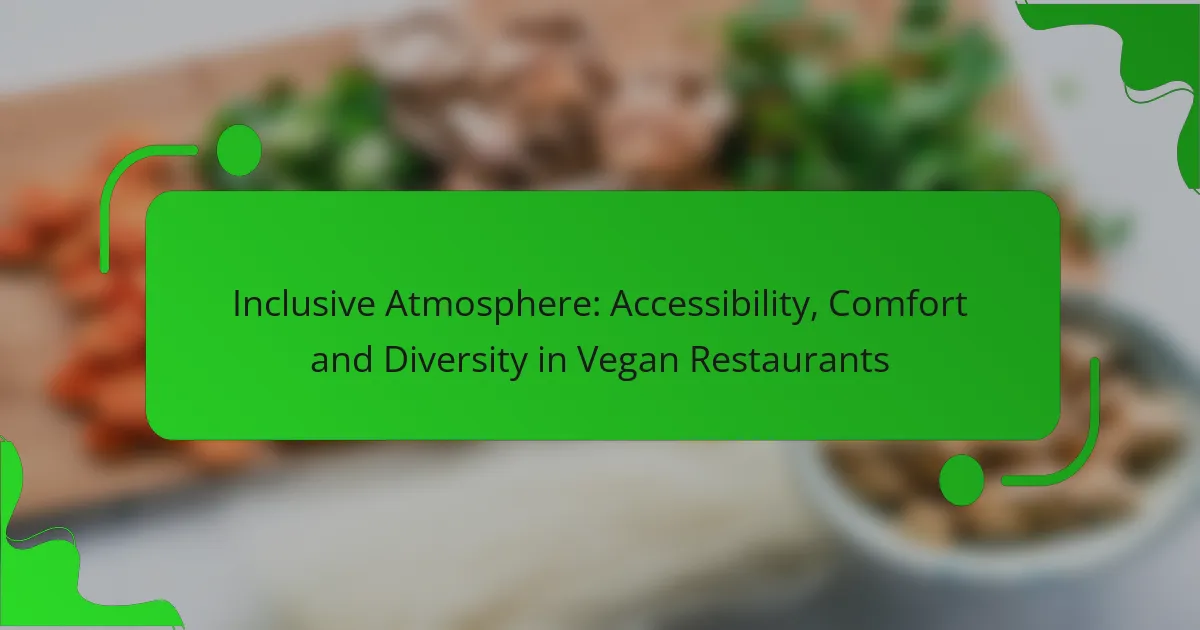The comparison of service quality between vegan and traditional dining reveals distinct differences shaped by each restaurant’s approach to ingredients and culinary practices. Vegan establishments often emphasize fresh, local produce and attentive service, which can lead to higher customer satisfaction. In contrast, traditional venues may rely on established cooking methods, impacting the overall dining experience. Understanding these dynamics is essential for both diners and restaurant operators alike.

How does service quality differ between vegan and traditional dining in Los Angeles?
Service quality in vegan and traditional dining in Los Angeles can vary significantly, often influenced by the restaurant’s focus on ingredient sourcing and culinary techniques. Vegan establishments typically prioritize fresh, local produce, while traditional venues may emphasize established cooking methods and classic recipes.
Vegan dining emphasizes fresh, local ingredients
In vegan dining, the emphasis on fresh and local ingredients often leads to a more personalized service experience. Staff are usually well-informed about the sourcing of their ingredients, allowing them to provide detailed recommendations and insights about the dishes. This focus can enhance the dining experience, as patrons are more likely to receive tailored suggestions based on seasonal offerings.
Moreover, many vegan restaurants in Los Angeles may adopt a farm-to-table approach, which not only supports local farmers but also ensures that the ingredients are at their peak freshness. This commitment can result in a more engaging atmosphere, where servers may share stories about the farms or producers behind the meals.
Traditional dining often relies on established culinary techniques
Traditional dining in Los Angeles frequently showcases established culinary techniques that have been refined over time. This can lead to a more standardized service experience, where staff are trained to deliver consistent quality across a wide range of classic dishes. The familiarity of these techniques often means that patrons can expect a certain level of expertise in preparation and presentation.
However, this reliance on tradition can sometimes result in less flexibility in menu offerings. Traditional restaurants may not adapt their dishes as readily to accommodate dietary preferences, which can affect the overall service experience for vegan diners. Understanding these differences can help patrons choose the dining experience that best suits their preferences and needs.

What factors influence service quality in vegan restaurants?
Service quality in vegan restaurants is influenced by staff training, customer education, and the overall dining experience. Understanding these factors can enhance both customer satisfaction and operational efficiency.
Staff training on vegan cuisine
Staff training is crucial in vegan restaurants as it ensures that employees are knowledgeable about plant-based ingredients and cooking methods. Well-trained staff can confidently answer questions about the menu, suggest pairings, and accommodate dietary restrictions, which enhances the dining experience.
Training programs should cover not only the specifics of vegan dishes but also the importance of cross-contamination prevention for those with allergies. Regular workshops and tastings can keep staff updated on new trends and ingredients in vegan cuisine.
Customer education on menu options
Customer education plays a significant role in service quality at vegan restaurants. Providing clear information about menu items, including ingredients and preparation methods, helps diners make informed choices and feel more comfortable with their selections.
Restaurants can utilize menus with detailed descriptions, offer tastings, or host events that educate patrons about the benefits of vegan dining. Engaging customers through social media or newsletters can also enhance their understanding and appreciation of vegan options, leading to a better overall experience.

How does customer satisfaction compare in vegan vs. traditional dining?
Customer satisfaction in vegan dining often surpasses that of traditional dining, primarily due to the emphasis on quality ingredients and unique flavors. Many diners report a more positive experience in vegan establishments, which can be attributed to attentive service and a focus on customer preferences.
Higher satisfaction reported in vegan establishments
Vegan restaurants frequently receive higher satisfaction ratings because they cater to health-conscious consumers and those seeking diverse culinary experiences. Diners appreciate the creativity in plant-based dishes, which can lead to a more enjoyable meal overall.
Moreover, the commitment to sustainability and ethical sourcing in many vegan establishments resonates with customers, enhancing their overall dining experience. This alignment with values often results in greater loyalty and positive word-of-mouth recommendations.
Traditional dining often has loyal customer bases
Traditional dining establishments typically benefit from established customer loyalty, with many patrons returning for familiar dishes and a sense of comfort. This loyalty can lead to consistent satisfaction, especially among those who prefer classic flavors and traditional cooking methods.
However, while traditional restaurants may have loyal customers, they often face challenges in adapting to changing dietary preferences. As more diners seek healthier or plant-based options, traditional establishments may need to innovate to maintain satisfaction levels and attract new customers.

What are the key service attributes in vegan dining?
Key service attributes in vegan dining focus on staff knowledge, personalized experiences, and attentiveness to dietary needs. These elements significantly enhance the dining experience for vegan customers, ensuring their preferences and restrictions are respected.
Knowledgeable staff about dietary restrictions
In vegan dining, having knowledgeable staff is crucial. They should be well-versed in the ingredients and preparation methods to answer questions about allergens and dietary restrictions effectively. This expertise helps build trust and ensures that customers feel safe and informed about their meal choices.
Restaurants can enhance staff knowledge through regular training sessions and updates on vegan ingredients. For example, staff should be able to explain the difference between vegan and vegetarian options and identify hidden animal products in common dishes.
Personalized dining experiences
Personalized dining experiences in vegan restaurants often involve tailoring meals to individual preferences and dietary needs. This can include customizing dishes based on allergies, flavor preferences, or nutritional goals. Such attention to detail can significantly elevate the overall dining experience.
To achieve personalization, restaurants might offer options for ingredient substitutions or allow customers to create their own dishes. For instance, a vegan restaurant could provide a base of grains and allow guests to choose from a variety of vegetables, proteins, and sauces, ensuring each meal is unique and satisfying.

What are the key service attributes in traditional dining?
Key service attributes in traditional dining include consistency in food quality and established service protocols. These elements ensure that diners receive a reliable experience, which is crucial for customer satisfaction and repeat business.
Consistency in food quality
Consistency in food quality is vital for traditional dining establishments. Customers expect the same taste and presentation each time they visit, which builds trust and loyalty. This can be achieved through standardized recipes, regular staff training, and quality control measures.
For example, a restaurant may implement a system where chefs must follow specific cooking techniques and ingredient sourcing guidelines. This ensures that dishes meet the same standards, regardless of who is preparing them. Regular taste tests and feedback loops can further enhance this consistency.
Established service protocols
Established service protocols are essential for delivering a smooth dining experience. These protocols outline how staff should interact with customers, handle orders, and manage any issues that arise. Clear guidelines help maintain professionalism and efficiency.
For instance, a traditional restaurant might have a protocol for greeting guests within a few minutes of their arrival, taking orders promptly, and checking in during the meal. Training staff to follow these protocols can significantly improve service quality and customer satisfaction.

How do pricing strategies affect service quality perception?
Pricing strategies significantly influence how customers perceive service quality. Higher prices often lead to expectations of superior service, while lower prices can create assumptions of reduced quality, impacting overall dining experiences.
Vegan restaurants often have premium pricing
Vegan restaurants frequently adopt premium pricing strategies to cover the costs of high-quality, organic ingredients and specialized preparation methods. This can lead to a perception of enhanced service quality, as customers expect attentive service that matches the higher price point.
For instance, a vegan meal might cost between $15 to $30, reflecting the premium nature of the ingredients. Diners may anticipate personalized service, such as detailed menu explanations or tailored recommendations, which can enhance their overall experience.
Traditional dining may offer value menus
Traditional dining establishments often provide value menus that appeal to budget-conscious consumers. These menus typically feature lower-priced items, which can lead to a perception of less personalized service, as the focus shifts to volume rather than individual attention.
Value meals in traditional settings might range from $5 to $15, attracting a wider audience but potentially sacrificing the depth of service. Customers may experience quicker turnover and less interaction with staff, which can affect their overall satisfaction with the dining experience.

What are the emerging trends in vegan dining service quality?
Emerging trends in vegan dining service quality focus on enhancing customer experience through personalized service, innovative menu options, and sustainable practices. As the demand for vegan cuisine grows, restaurants are prioritizing staff training and ingredient sourcing to improve overall service standards.
Personalized Customer Experience
Vegan dining establishments are increasingly adopting personalized service to cater to diverse dietary preferences and restrictions. Staff training emphasizes understanding individual customer needs, allowing for tailored recommendations and modifications to dishes. This approach not only enhances satisfaction but also fosters loyalty among patrons.
For instance, restaurants might implement systems to track customer preferences, enabling them to suggest new dishes based on past orders. This level of attention can significantly elevate the dining experience, making guests feel valued and understood.
Innovative Menu Options
To stay competitive, vegan restaurants are expanding their menus with creative and diverse offerings. This includes incorporating global cuisines and experimenting with unique ingredients to appeal to a broader audience. Seasonal menus and limited-time offerings can also create excitement and encourage repeat visits.
Examples include plant-based versions of traditional dishes, such as vegan sushi or gourmet burgers, which not only attract vegans but also meat-eaters curious about plant-based options. By continually refreshing their menus, these establishments can maintain high service quality and customer interest.
Sustainable Practices
Sustainability is becoming a key focus in vegan dining, with many restaurants adopting eco-friendly practices that enhance service quality. This includes sourcing local and organic ingredients, minimizing food waste, and using biodegradable packaging. Such practices resonate with environmentally conscious consumers, adding value to the dining experience.
Restaurants may also engage in community initiatives, such as supporting local farmers or participating in environmental campaigns. These efforts not only improve service quality but also align the restaurant’s brand with the values of its clientele, fostering a deeper connection with customers.



